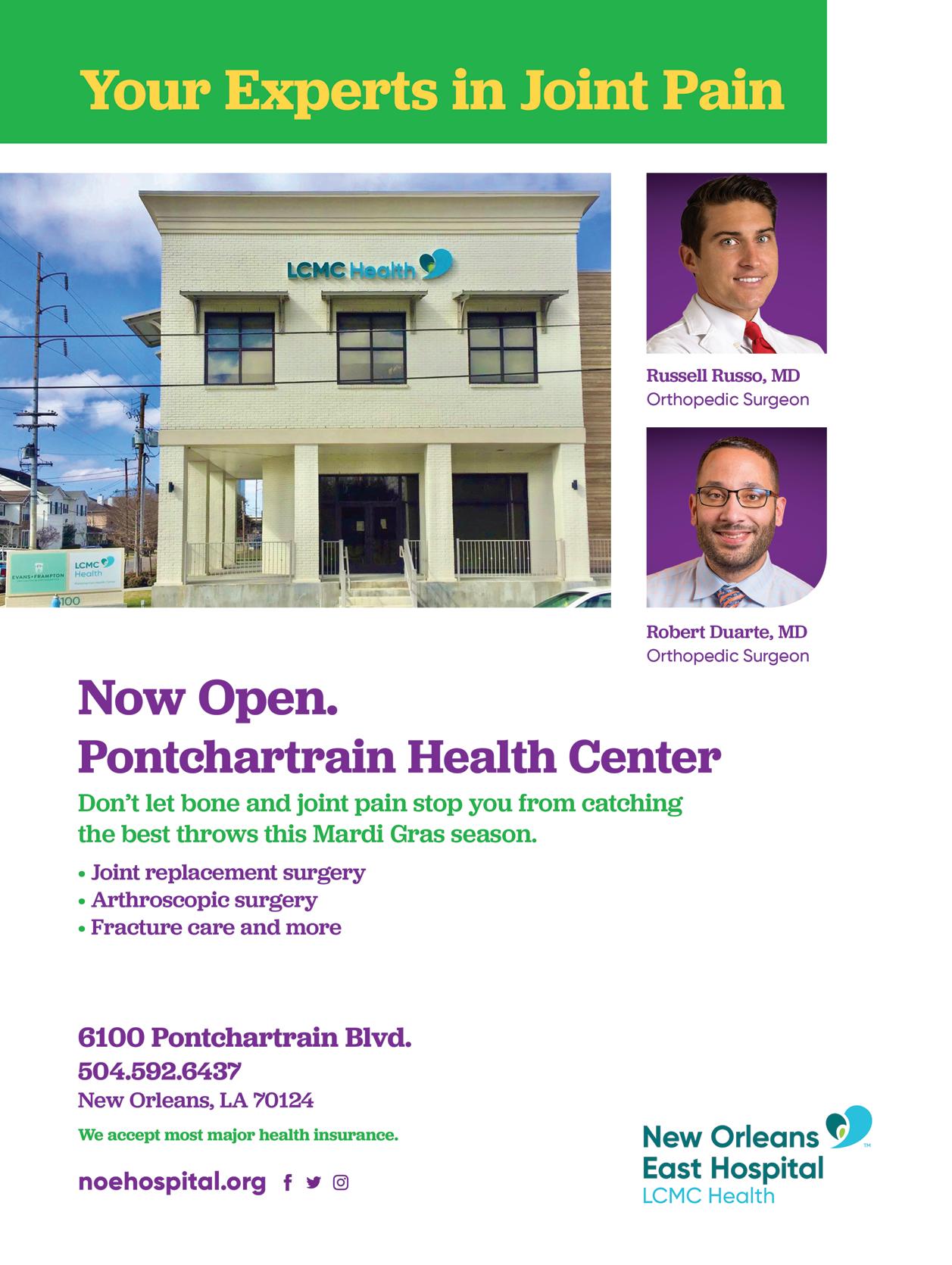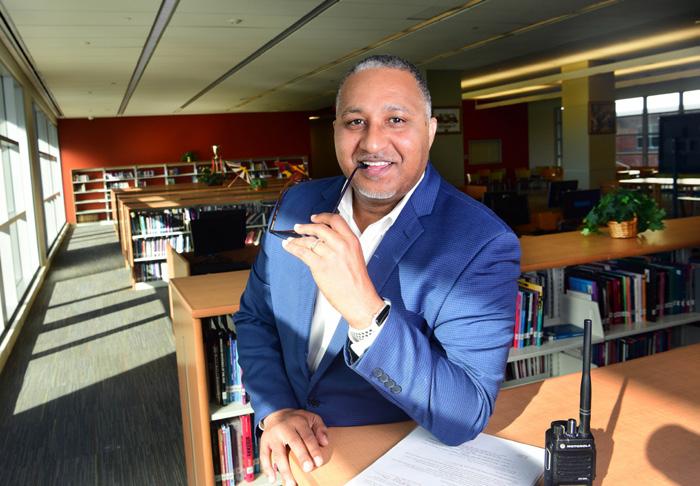
9 minute read
Investment in Education
Schools in New Orleans East benefit from the largest school recovery program in the history of the United States.
The educational environment in New Orleans East has come a long way over the past two decades, both in terms of infrastructure, curriculum and student performance. As new businesses, investors and residents move into the area, New Orleans East is poised to reach even greater heights — and in light of this economic growth, it becomes increasingly important to usher in a stronger workforce that is prepared to succeed in modern roles.
Great strides have already been taken. Schools in the East are making deliberate efforts to expand extracurricular activities and to maintain student/teacher ratios that enable personalized attention and nurturing (see pages 14–17). The 2019 Louisiana Teacher of the Year has made it his personal mission to serve as a positive role model for young boys in the East (see page 18), and AT&T is leading an effort to train and educate the adult workforce in STEM-related fields (see page 20). The journey there wasn’t always easy, and it took the combined efforts of several organizations like the Recovery School District (RSD), the Orleans Parish School Board (OPSB) and CSRS to get us where we are now. But now that the foundation has been laid, one thing is certain: The East is seeing yet another revitalization, and for students, teachers, and parents, the best is yet to come.
HOW WE GOT HERE: THE RECOVERY EFFORT
It all started in 2003, when the Louisiana Legislature created the RSD — a division of the Louisiana Department of Education — with the mission of improving the lowest performing schools in the state. Even before Hurricane Katrina hit New Orleans in August 2005, many of the Crescent City’s schools, especially in New Orleans East, were in major need of redevelopment and overall improvement in student performance. Prior to the hurricane, RSD took over low-performing schools to improve academics. Then, when Hurricane Katrina severely damaged or destroyed more than 100 school buildings in the city, students had nowhere to go. The RSD’s mission then shifted from test scores to providing clean, dry and safe buildings for students.
In 2007, the RSD turned to CSRS (in a joint venture with Jacobs Project Management Co.) to embark on a journey to rebuild the city’s schools. RSD and OPSB reached an unprecedented $1.8 billion FEMA settlement in 2010 — the largest school recovery program in the history of the United States — to fund a more comprehensive construction plan. With the settlement, the RSD was equipped with a streamlined and efficient funding process, along with the necessary funding to make significant progress on the school board’s School Facilities Master Plan (SFMP). In addition to FEMA funding, CSRS helped the RSD secure funding from a number of other sources, including the Hazard Mitigation Grant Program, Community Development Block Grants, and historic and new markets tax credits. Together, these funding sources have been crucial to helping the RSD in its mission to rebuild New Orleans’ schools.
In 2011, the RSD and OPSB implemented a comprehensive amendment process focused on transforming the SFMP into a true Recovery Plan that would better meet the needs of more students. The amendments included assessing available revenue; updating and analyzing student demographic projections to accommodate changing repopulation patterns in the city; and developing a clear plan for selecting projects to undertake. As part of the process, the RSD held a minimum of three community meetings for each new or renovated school to collect community feedback on the proposed amendments and consulted numerous experts and school operators to develop educational and technical specifications. OPSB and BESE approved the amendments in October 2011.
Then, in 2012, the RSD and OPSB set goals to ensure Disadvantaged Business Enterprises (DBE) would be able to participate in the rebuilding of New Orleans’ schools. This federal program under the Department of Transportation provides small businesses owned and controlled by socially and economically disadvantaged individuals a fair opportunity to compete for federally funded transportation contracts.
As of March 2015, the RSD and OPSB secured $146.2 million in DBE contracts, with more than 100 business participating in the program. And 25 percent of all projects bid since June 2012 have gone to DBEs, thereby benefiting small businesses in the local economy.
“Utilizing extensive community input, along with [the] historic FEMA agreement, schools are rebuilt in a way that best serves the city’s population, and not simply returned to their pre-disaster condition,” says Annie Cambria, Chief Operating Officer, Education Facilities Development for the RSD. “The SFMP capital program includes many dynamic approaches: the first state agency to implement a Disadvantaged Business Enterprise program; the first to utilize alternative construction delivery methods such as Construction Management at Risk;and the first to stack multiple funding sources, such as historic and new markets tax credits to supplement federal grant funding.” Between 2007 and 2016, the RSD renewed its contract with CSRS and Jacobs three times and worked through three phases of the SFMP capital program. The result was more than 3.8 million square feet of renovated or new educational spaces, and 35,175 new or refurbished student seats.
Edward R. Livingston HS (currently operating as Livingston Collegiate Academy) 7301 Dwyer Road
Ernest Morial Elementary School (currently operating as KIPP Morial School) 7701 Grant Street
Fannie C. Williams Middle School (currently operating as Fannie C. Williams Charter School) 11755 Dwyer Road
Gaudet Elementary School (permanently closed) 12000 Hayne Boulevard
Henry C. Schaumburg Elementary School (currently operating as ReNEW Schaumburg Elementary) 9501 Grant Street Holy Cross Modulars (at current Abramson Sci Academy location) 5552 Read Boulevard
Little Woods Elementary School (now operating as ReNEW Dolores T. Aaron Academy) 10200 Curran Boulevard
Marion Abramson High School / New Orleans East Abramson (currently operating as Abramson Sci Academy) 5552 Read Boulevard Ray Abrams Elementary School (currently operating as KIPP East Community Primary) 6519 Virgilian Street Sarah T. Reed High School (currently operating as Einstein Charter High School at Sarah Towles Reed) 5316 Michoud Boulevard
Sherwood Forest Elementary School (currently operating as Einstein Charter School at Sherwood Forest) 4801 Maid Marion Drive Village De L’est (currently operating as Einstein Charter School at Village De L’est) 5100 Cannes Street
New PK-8 at Kenilworth Park/ Curran Site (currently operating as Robert Russa Moton Charter School) 8500 Curran Boulevard New Lake Forest School at Greater St. Stephens Site (currently operating as Lake Forest Elementary Charter School) 11110 Lake Forest Boulevard
$47,378 $36,873 $39,682 $3,808 $9,383 $360 $26,313 $59,699 $35,196 $15,480 $31,090 $6,602 $25,284 $37,750
New Construction Demolished for New Construction Refurbishment Temporary Modular Campus Contents
LOOKING TO THE EAST: REBUILDING AND REVITALIZING
Approximately $375 million were invested in New Orleans East following the FEMA settlement, allowing for long overdue changes to be made to existing schools, as well as new constructions and innovations to be brought into the area.
Some examples have included the demolition of Livingston Middle School and the construction of Edward R. Livingston High School, now rebranded as the Livingston Collegiate Academy; a new roof and new windows at ReNew Schaumburg, formerly known as Henry C. Schaumburg Elementary; and the construction of Einstein Charter School at Sherwood Forest (a brand new PreK-8 school).
The school in most need of funding was Marion Abramson High School. It received close to $59.7 million and included the demolition of the existing school, the construction of a temporary modular campus, and the new construction of the school (now known as Abramson Sci Academy). This massive reinvestment in new and renovated schools has resulted in the city’s graduation rate rising from 54 percent pre-Katrina to 72.8 percent by 2017. In 2005, only 33 percent of New Orleans students scored basic or above on state assessments for elementary and middle school. In 2017, that percentage rose to 53 percent, reducing the performance gap between New Orleans and the state from 24 percent in 2005 to 9 percent in 2017. Moreover, since 2005, New Orleans has increased the percentage of high school graduates enrolling in college the fall after their graduation from 37 percent up to 61 percent in 2017.
Meanwhile, another school — North Kenilworth, currently named Robert Russa Moton Charter School — was developed in New Orleans East by OPSB rather than CSRS to double down on growth efforts in the area. The new facility was completed in 2016 with funds from FEMA. “It was a $21 million budgeted project listed in the first phase of schools to be built in 2008 under the city’s Master Plan,” Smith says. “However, it was the last school to be built before the funds ran out. At a low point in 2018, the school received a failing School Performance Score for the first time. In 2019, under new administration, the school improved by a letter grade and is on the rise again.Moton’s reputation remained strong in spite of the temporary decline.”
Moton — a performing arts and technology-themed school — has received all of the innovations promised in the district’s Master Plan. Modernizations for all PreK-12 facilities include appropriately sized classrooms; science labs; LEED Silver certification; dining halls with full serving kitchens; spaces designed for the arts; media centers; competition gymnasiums; auditorium performance space; special needs and resource rooms; and more. In its current location, the enrollment is approximately 462 students in grades PreK-8. According to Smith, this enrollment represents an increase of more than 80 students from 2018-19.
Other school improvements in New Orleans East included the new construction of Lake Forest Charter School; the $35 million demolition and construction of KIPP East Community Primary, formerly Ray Abrams Elementary School, which is outfitted with science labs, a media center, music rooms and a stage; the demolition and new construction of Ernest Morial Elementary School, now known as KIPP Morial School; and the demolition and construction of Edward Livingston High School, now known as Livingston Collegiate Academy.
As shown in the following infographic, more than a dozen schools in New Orleans East benefitted from the $1.8 billion settlement and the School Facilities Master Plan.
PREPARING THE FUTURE WORKFORCE: KEEPING THE MOMENTUM
Today, the RSD’s role in New Orleans consists of fulfilling its continued responsibility for the completion of the Schools Facilities Master Plan, with projects in the East nearing ultimate completion.
“All of the schools in the School Facilities Master Plan in New Orleans East are complete except for the demolition of the Sarah T. Reed modular campus, which will be completed this summer,” Cambria says. “The completion of the Master Plan will result in 79 new, renovated or refurbished school facilities. All of the new and renovated structures have been built to ADA standards, with light and air quality vastly improved and energy-efficiency greatly enhanced.” With the significant investment made by RSD to rebuild schools in the city, the Orleans Parish Schools in New Orleans East are well-prepared to meet the city’s educational needs for decades to come, all while providing the infrastructure to support students and permanent jobs in the local economy. It may have taken a disaster to spur this long-awaited change, but New Orleans East is nothing if not resilient, and officials and residents alike have worked hard to turn the tides for the community.
And with improving student scores and college enrollment rates, schools in New Orleans East will continue to attract growing numbers of students and teachers who can now benefit from vastly improved facilities as compared to pre-Katrina schools. All of these benefits combined promise increased economic growth for New Orleans East — and for the entire region — as students go on to join the workforce equipped with 21st century skills.










